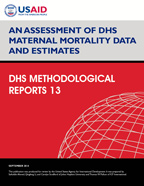- PUBLICATIONS
- JOURNAL ARTICLES
- ACCESS PUBLICATIONS
Publications Summary
- Document Type
- Methodological Reports
- Publication Topic(s)
- Maternal Mortality
- Language
- English
- Recommended Citation
- Ahmed, Saifuddin, Qingfeng Li, Carolyn Scrafford, and Thomas W. Pullum. 2014. An Assessment of DHS Maternal Mortality Data and Estimates. DHS Methodological Reports No. 13. Rockville, Maryland, USA: ICF International.
- Download Citation
- RIS format / Text format / Endnote format
- Publication Date
- September 2014
- Publication ID
- MR13
Download
 An Assessment of DHS Maternal Mortality Data and Estimates (PDF, 2837K)
An Assessment of DHS Maternal Mortality Data and Estimates (PDF, 2837K)
